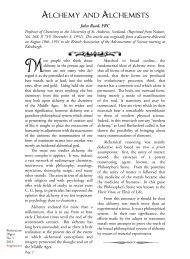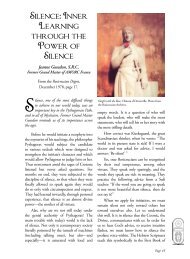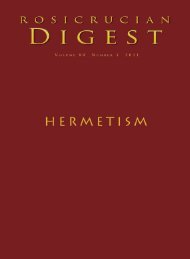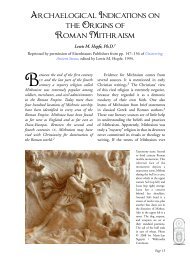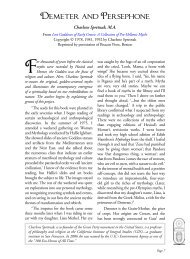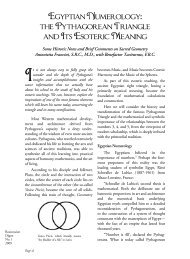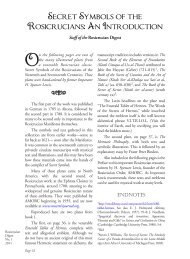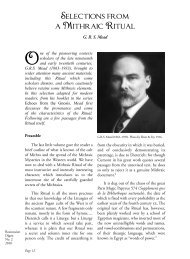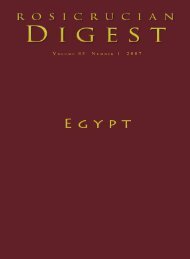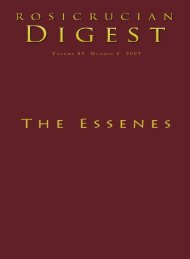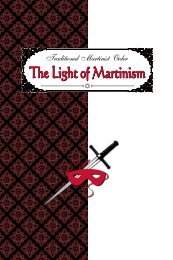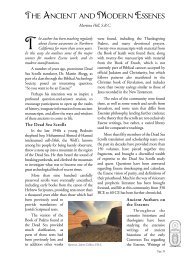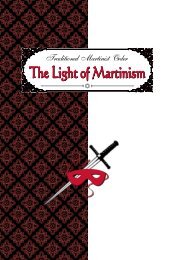The Orphic Mysteries - Rosicrucian Order
The Orphic Mysteries - Rosicrucian Order
The Orphic Mysteries - Rosicrucian Order
Create successful ePaper yourself
Turn your PDF publications into a flip-book with our unique Google optimized e-Paper software.
<strong>The</strong> <strong>Orphic</strong> <strong>Mysteries</strong><br />
Joscelyn Godwin, Ph.D.<br />
From <strong>The</strong> Golden Thread, by Joscelyn Godwin, ©2007, reproduced by permission<br />
of Quest Books, the imprint of the <strong>The</strong>osophical Publishing House, http://www.<br />
questbooks.net.<br />
<strong>Rosicrucian</strong><br />
Digest<br />
No. 1<br />
2008<br />
Joscelyn Godwin is one of the leading<br />
scholars of esotericism today. In Chapter 3<br />
of his recent survey of the Western esoteric<br />
movement, <strong>The</strong> Golden Thread, he considers<br />
the primal figure of Orpheus and the <strong>Mysteries</strong><br />
connected with his name and legend.<br />
<strong>The</strong> distant figure of Hermes Trismegistus<br />
seems superhuman, without faults and<br />
equally without character, and the same goes<br />
for Zoroaster, at least until the late nineteenth<br />
century, when Nietzsche humanized<br />
and humorized him in Also Sprach Zarathustra.<br />
Imagining Orpheus is a<br />
different matter. Most people<br />
can recall two things about<br />
him: that he was a musician,<br />
and that he went down<br />
to the Underworld to fetch<br />
his wife Eurydice. His story<br />
is the archetypal myth of the<br />
power of music. With the lyre<br />
that was a gift from Apollo,<br />
Orpheus could move everything<br />
in creation, from stones,<br />
trees, and beasts, through<br />
humans, to daimonic and even<br />
divine beings (whom we might<br />
call angels and gods). Armed<br />
only with his songs, he<br />
charmed the denizens of Hades<br />
and persuaded Pluto and Persephone<br />
to let him take Eurydice back.<br />
Orpheus was a prince of Thrace, the<br />
land to the north of Greece. His mother<br />
was Calliope, the Muse of epic poetry. Some<br />
say that his father was Apollo, and certainly<br />
Orpheus stands under the patronage of that<br />
god. Apollo also had northern connections,<br />
either coming from Hyper borea (the land<br />
beyond the North Wind), or else visiting<br />
that far northern land after his birth on the<br />
Page 48<br />
<strong>The</strong> setting sun through one of the<br />
trilithons of Stonhenge. Photo by Resk,<br />
Wikimedia Commons,<br />
island of Delos. Where was this Hyperborea?<br />
As it was said to contain a circular temple to<br />
the sun, some have identified it with Britain,<br />
and its temple with Stonehenge, a monument<br />
far older than any in Greece.<br />
Stonehenge, and the people who constructed<br />
it, were Apollonian in the sense of<br />
being dedicated to the sun, to astronomy,<br />
mathematics, and music. A number of<br />
modern researchers have penetrated beyond<br />
the limitations of academic prehistory to<br />
reveal, through intuition, the bases of this<br />
ancient science. John Michell,<br />
the pioneer in this regard,<br />
has reconstructed the diagrams<br />
and dimen sions that<br />
seem to lie at the basis of<br />
megalithic design. 1 Jean<br />
Richer has shown that there<br />
is an imaginary zodi ac whose<br />
twelvefold symbolism links<br />
mythology with the geography<br />
of the Aegean area. 2<br />
Paul Broadhurst and<br />
Hamish Miller have traced a<br />
plethora of Apollonian sites<br />
in geometrical alignment,<br />
all the way from Ireland to<br />
Palestine. 3 Michell, in addition,<br />
has traced the myth of<br />
“perpetual choirs” maintained<br />
at ancient sanctuaries for the purpose of<br />
what he calls “enchanting the landscape.” 4 If<br />
one is attentive to such findings, it is clear<br />
that there was a high and orderly civilization<br />
well established by the third millennium<br />
BCE, of which the archaeologists know<br />
almost nothing.<br />
This enchantment of the landscape is<br />
exactly what Orpheus is reputed to have<br />
done with his music, casting a benign spell
over nature and bringing peace among men.<br />
As part of his mission, he reformed the cult<br />
of Dionysus (Bacchus) and tried to persuade<br />
its followers to give up their blood sacrifices.<br />
In place of the Dionysian orgies, Orpheus<br />
founded the first <strong>Mysteries</strong> of Greece. <strong>The</strong><br />
purpose of these, as far as we can tell, was to<br />
transmit some kind of direct knowledge that<br />
was helpful in facing the prospect of death.<br />
Orpheus’s journey to the Underworld<br />
to fetch Eurydice should be understood in<br />
the context of the <strong>Mysteries</strong>. 5 In the earliest<br />
versions of the myth, he did succeed in restoring<br />
her to life. Only later was the episode<br />
embroidered by the poets 6 so that it ended<br />
tragically, as Orpheus at the last moment<br />
disobeyed the ban on looking at his wife<br />
before he reached the surface of the earth,<br />
and lost her again forever.<br />
Orpheus was originally a psychopomp<br />
(leader of souls) who had the power to<br />
rescue souls from the gray, dreamlike condition<br />
that was believed in archaic times to<br />
be the inevitable fate of the dead. Initiates<br />
of the <strong>Mysteries</strong> received the assurance that<br />
this would not be their fate, and that like<br />
Eurydice they would be saved from Pluto’s<br />
dismal realm. This was the first time that the<br />
immortality of the soul was taught on Greek<br />
soil, beginning a tradition that Pythagoras,<br />
Socrates, and Plato would each enhance in<br />
his own way. (See chapters 4 and 5 [Ed: of<br />
<strong>The</strong> Golden Thread].)<br />
Most of what we know of Orphism<br />
derives from much later even than these<br />
philosophers. Under the Roman Empire,<br />
around the time of early Christianity, there<br />
was a strong resurgence of Orphism as a<br />
mystery religion. <strong>The</strong> <strong>Orphic</strong> Hymns, a set<br />
of magical incantations addressed to the<br />
various gods and daimons, date from this<br />
revival. 7 Far from discard ing the worship of<br />
Dionysus, Orphism now made him the very<br />
core of its doctrine. One of the myths of<br />
Dionysus tells that as an infant he was captured<br />
by the Titans (the rivals of the gods),<br />
who dismembered and ate him. Fortunately<br />
Zeus was able to save his son’s heart. He<br />
swallowed it himself, and in due time gave<br />
Dionysus second birth. <strong>The</strong> Titans were<br />
vanquished, and out of their remains came<br />
human beings. Consequently, every human<br />
body contains a tiny fragment of Dionysus.<br />
It is easy to recognize in this myth the<br />
doctrine, famil iar now but by no means<br />
common then, that each person is not just<br />
a compound of body and soul, but also possesses<br />
a spark of absolute divinity. Religions<br />
that hold this doctrine are aimed at retrieving,<br />
reviving, and eventually realizing that<br />
spark, either in life or after death. To realize<br />
it—to “make it real”—is to become oneself<br />
a god, and henceforth immortal. That<br />
is the ultimate promise of the <strong>Mysteries</strong>. For<br />
the uninitiated, there is only the prospect of<br />
Hades, a place not of torment except for the<br />
very wicked, but not of pleasure, either, even<br />
for the best of men. Eventually the soul there<br />
withers and dies, releasing the divine spark<br />
to reincarnate in another body and soul.<br />
This touches once again on the matter<br />
of conditional immortality (see chapter 2<br />
[Ed: of <strong>The</strong> Golden Thread].), which is a<br />
constant concern of esoteric teaching and<br />
practice. <strong>The</strong> distinction is implicit as early<br />
as Homer’s Odyssey, though the relevant<br />
passage is probably an interpolation from<br />
classical times. When Odysseus sees the<br />
heroes in Hades, even the greatest of them is<br />
stuck there without hope of ascent, redemption,<br />
or rebirth. A single exception is made<br />
for Hercules. Odysseus, it is said, saw only<br />
his image in Hades, while Hercules “himself”<br />
is among the eternal gods. 8<br />
Hercules here represents the initiate,<br />
who is supposed ly freed from this wheel of<br />
birth and death and is able to proceed to<br />
a more glorious destiny among the gods.<br />
As a reminder, the <strong>Orphic</strong> initiates were<br />
not buried with pots of food and furniture,<br />
but cremated and buried with gold<br />
leaves inscribed in Greek. 9 <strong>The</strong>se carry<br />
prayers and instruc tions about what they<br />
should say and do upon awakening after<br />
death. <strong>The</strong>y must avoid at all costs drinking<br />
from the Lake of Lethe (forgetfulness),<br />
Page 49
<strong>Rosicrucian</strong><br />
Digest<br />
No. 1<br />
2008<br />
but instead turn to the right, to the Lake<br />
of Mnemosyne (memory), and address its<br />
guardians in these beautiful words: “I am<br />
the child of earth and of starry Heaven.<br />
This you yourselves also know. I am dry<br />
with thirst and am perishing. Come, give<br />
me at once cold water flowing forth from<br />
the Lake of Memory.” Or, on meeting the<br />
rulers of Hades, they should say: “I come<br />
pure from the pure, Queen of the Underworld,<br />
Eucles, Eubou leus, and all other<br />
gods! For I too claim to be of your race.”<br />
By the Roman period, as we read in<br />
Ovid’s version of his story, 10 the figure of<br />
Orpheus had become a tragic one. Not only<br />
did he lose Eurydice for the second time,<br />
but he himself suffered a cruel death. It is<br />
said that he returned to his native Thrace<br />
to try to reform the inhabitants, but fell<br />
afoul of the Maenads, women followers of<br />
the unregenerate rites of Dionysus. Screaming<br />
to silence his magical songs, they tore<br />
him limb from limb. But his head floated<br />
to the sea and lodged in a rock on the isle<br />
of Lesbos, where it continued to sing. He<br />
himself was taken up by his father Apollo,<br />
and his lyre was raised to the stars as the<br />
constel lation Lyra.<br />
With this version of his myth, Orpheus<br />
took his place among the other suffering<br />
saviors whose cults were popular in cosmopolitan<br />
Rome: Dionysus, Attis, Adonis,<br />
Hercules, Osiris, and Jesus of Nazareth. 11<br />
<strong>The</strong>se divine beings offered a personal relationship<br />
with their worshipers that many<br />
people found more satisfying than the distant<br />
Olympian gods. <strong>The</strong> implication was<br />
that as the gods had suffered, died, and<br />
returned to their native heaven, so would<br />
their followers.<br />
Some of the early Christians regarded<br />
Orpheus as a kind of pagan saint, even confusing<br />
his image with that of Jesus. Both<br />
saviors were demigods of royal descent who<br />
sought to refashion an existing religion in<br />
the interests of humanitarianism. Both<br />
descended into Hades to rescue loved ones<br />
from eternal death. (Jesus’ descent into<br />
Hades to deliver the souls of the Old<br />
Page 50<br />
Testament fathers is not bibli cal, but has<br />
been standard doctrine since the second<br />
cen tury). 12 <strong>The</strong>ir religions taught the<br />
potential immortality of the soul, depending<br />
on one’s actions in life. Both suffer ed<br />
tragic deaths as sacrifices to the religions<br />
they had tried to reform: Orpheus, as the<br />
dismembered victim of the Dionysian orgy;<br />
Jesus, in the image of the Lamb slain for<br />
the Passover supper. <strong>The</strong>ir relations with<br />
their parent reli gions were highly ambiguous.<br />
Jesus, while acknowledging the Jewish<br />
god Yahweh as his heavenly father, treated<br />
the Mosaic Law with disdain, and supposedly<br />
died on the cross to appease his father’s<br />
anger with humanity. Orpheus was killed<br />
by the sectaries of Dionysus, imitating the<br />
latter’s death at the hands of the Titans.<br />
<strong>The</strong> importance placed on the next life<br />
encouraged <strong>Orphic</strong>s and Christians alike<br />
to defer their pleasures in this one. Both<br />
groups sought to live a life of chastity and<br />
absti nence (the <strong>Orphic</strong>s were vegetarians)<br />
that was incongruous with the society<br />
around them. It was also cause for surprise<br />
that both practiced friendship to strangers,<br />
not merely to people of their own race and<br />
creed, as the Greeks and Jews tended to do.<br />
But this was a natural conclusion from the<br />
principle that each person was in essence<br />
divine. Conse quently Orphism was the first<br />
religion in Europe, and per haps the first<br />
anywhere, to preach what we think of as<br />
“Christian” virtues, to promise an afterlife<br />
whose quality depended on their practice,<br />
and to institute mysteries as a foretaste of<br />
the soul’s future destiny.<br />
<strong>The</strong> <strong>Orphic</strong>s had been the first philosophers<br />
of Greece and the spiritual<br />
ancestors of the Pythagorean and Platonic<br />
schools, renowned for asceticism and for<br />
belief in the immor tality of the soul. Now,<br />
in the <strong>Orphic</strong> revival, they stamped their<br />
principles on the new religion. Through<br />
numerical coding of key words and phrases<br />
in the Greek (New) Testament, Christianity<br />
was linked with the Pythagorean tradi tion,<br />
in which music and number were the first<br />
principles of the universe. 13
But this knowledge was not for general<br />
consumption. In two respects, Orphism<br />
was the first known esoteric religion. First,<br />
it imposed the seal of the <strong>Mysteries</strong>, so that<br />
the teachings given in initiation were not<br />
revealed to outsiders. Second, it gave a profounder,<br />
symbolic inter pretation to existing<br />
myths such as the <strong>The</strong>ogony (the genealogy<br />
of the Greco-Roman gods). <strong>Mysteries</strong> and<br />
the knowledge of hidden meanings in the<br />
scriptures have since been two of the chief<br />
marks of esotericism.<br />
<strong>The</strong> <strong>Orphic</strong> impulse survives to this<br />
day, not in religion so much as in the arts, of<br />
which Apollo is the traditional patron and<br />
the Muses the inspirers. <strong>The</strong>se “arts” were<br />
orig inally disciplines that were closer in some<br />
ways to what we call sciences: they included<br />
history and astronomy, along with dance,<br />
music, poetry, and drama. 14 <strong>The</strong>ir effects<br />
were calculated, even in the literal sense<br />
of being governed by mathematics. This<br />
is obvious in the cases of astronomy and<br />
music. But poetry, too, is speech controlled<br />
by rhythmic number; dance is rhythmic and<br />
geometrical movement; drama and history<br />
control the unruly memories and rumors of<br />
earthly and divine events and turn them into<br />
moral and philosophical lessons.<br />
Whatever the status of the arts today, the<br />
Muses were originally not in the business of<br />
entertain ing people but of civilizing them,<br />
using deliberate and highly developed techniques<br />
based, for the most part, on number.<br />
This brings us back to the elaborate mathematics<br />
of Stonehenge and other prehistoric<br />
monuments, and to John Michell’s vision of<br />
a civilization held in a state of grace by the<br />
tireless chanting of a mantic song, its music<br />
ruled by number and proportion. 15<br />
Orpheus, singing to Apollo’s lyre, is<br />
said to have had the power to move every<br />
kind of body and soul. He could force apart<br />
the Clashing Rocks so that the ship of the<br />
Argonauts could pass safely between them;<br />
he succeeded in touching the hearts of the<br />
chthonic gods. Stones that have been “moved”<br />
and set in geometrical order are the substance<br />
both of Stonehenge and of the Greek temples,<br />
monuments that even in their ruin command<br />
awed respect and convey a sense of sublime<br />
harmony. Music, too, though it may consist<br />
of nothing more than air vibrating according<br />
to mathematical laws, has always had an<br />
unaccountable power to touch the heart and<br />
exalt the spirit. In a well-ordered civilization,<br />
the two arts of architecture and music work<br />
in consort: the first, to provide harmonious<br />
surroundings for the body and to delight the<br />
eye; the second to delight the ear and to bring<br />
about harmony in the soul. Recent researches<br />
by Paul Devereux, Robert Jahn, and others,<br />
sug gest that this link of stone buildings with<br />
music goes back to the Stone Age. 16<br />
<strong>The</strong> <strong>Orphic</strong> and Apollonian ideal manifests<br />
in all those works of art that we call<br />
“classic.” <strong>The</strong>y are not exclusive to Greece by<br />
any means. In ancient China, for example,<br />
a hier atic music, along with religious ceremonies,<br />
was recognized as the best means of<br />
procuring peace in the empire and the good<br />
government of its citizens. 17 Mexico also<br />
has a version of Apollonian classicism in the<br />
architecture of the Mayas and their predecessors,<br />
which, like the European stone cir cles,<br />
was geometrically planned and cosmically<br />
oriented. 18 <strong>The</strong> West has had classic phases<br />
in all the arts whenever the peak of a certain<br />
style is reached, and with it an image of harmonious<br />
diversity as reassuring as the regular<br />
passage of the sun through the seasons.<br />
In Western music, the seven strings of<br />
Apollo’s lyre are sounded as the diatonic<br />
scale (the white notes of the piano). <strong>The</strong>ir<br />
most “classic” manifestation is not in Bach<br />
or Mozart but in plainsong, which served<br />
the Christian Church for fifteen hundred<br />
years or more before it was pushed aside by<br />
more glamorous types of music, then discarded<br />
alto gether. <strong>The</strong> calming, healing, and<br />
uplifting power of unac companied chant is<br />
intuitively felt by the soul, just as it was in<br />
the time of Orpheus. <strong>The</strong> fact that it was<br />
employed for a time in Christian worship<br />
and given Latin words is a secondary matter.<br />
Do music and the arts directly affect the<br />
quality of a civilization? No one can say for<br />
certain whether this <strong>Orphic</strong> premise is cor-<br />
Page 51
ect, because it has not been put into practice<br />
in modern times. Totalitarian governments<br />
have made a mockery of the idea. <strong>The</strong> Nazis<br />
banned atonal music because it was incomprehensible<br />
to their cultural pundits, and jazz<br />
because it was African-American in ori gin.<br />
<strong>The</strong> Russian Communists banned atonal<br />
music for the same reason, and rock ’n’ roll<br />
because it was associated with protest and<br />
Western influence. <strong>The</strong>se were hardly the<br />
proper motives for controlling a people’s<br />
music. But the rulers in question were not<br />
philosopher-kings, 19 who alone might be<br />
expected to have their subjects’ spiritual<br />
interests at heart, and to have the knowledge<br />
of how to further them.<br />
Even if depravity in the arts is not the<br />
cause of moral decay, it unfortunately mirrors<br />
many people’s spiritual state. <strong>The</strong> art critic<br />
Suzi Gablik, once a prominent mouthpiece<br />
for modernism, writes of how she emerged<br />
into this realization after an “acute crisis of<br />
credibility about the core truths of modernity<br />
—secularism, individualism, bureaucracy, and<br />
pluralism—by which the numinous, the<br />
mythic, and the sacramental have been, in<br />
our society, reduced to rags.” 20 When the arts<br />
are profane and purposeless, and dwell on<br />
ugliness and vice, one can be sure that the<br />
collective soul is not in good health. If the<br />
<strong>Orphic</strong>s are right, this is as seri ous a matter<br />
as the malnutrition of our nation’s poor. <strong>The</strong><br />
outlook is bleak for those souls nourished only<br />
by the junk food and poisonous additives of<br />
popular culture. How will it be for them to<br />
enter the soul’s domain with no songs to sing,<br />
no poetry to charm Pluto and Persephone?<br />
<strong>The</strong> <strong>Orphic</strong>, and the Christian, solution<br />
is not to force people but to gently persuade<br />
them toward a better way. One can see this<br />
in the actions of the founders, as they tried to<br />
reform the Dionysian and Mosaic traditions.<br />
One can also see it in America’s founders, who<br />
absorbed <strong>Orphic</strong> principles through Freemasonry,<br />
and deliberately chose freedom, not<br />
rigor, as the school for their citizens. 21 With<br />
an optimism that, on good days, we may still<br />
share, they allowed each person to regulate<br />
his or her own religious, aesthetic, and private<br />
life. In chapter 5 [Ed: of <strong>The</strong> Golden Thread],<br />
when we come to Plato’s prescriptions, we<br />
will consider the contrary policy.<br />
<strong>Rosicrucian</strong><br />
Digest<br />
No. 1<br />
2008<br />
1 See John F. Michell, <strong>The</strong> New View Over Atlantis (London:<br />
Thames & Hudson, 1987).<br />
2 Jean Richer, Sacred Geometry of the Ancient Greeks: Astrological<br />
Symbolism in Art, Architecture, and Landscape, trans. Christine<br />
Rhone (Albany, NY: State University of New York Press, 1994).<br />
3 Paul Broadhurst and Hamish Miller, <strong>The</strong> Dance of the Dragon:<br />
An Odyssey into Earth Energies and Ancient Religion (Launceston,<br />
UK: Pendragon Press, 2000).<br />
4 John Michell and Christine Rhone, Twelve-Tribe Nations and the<br />
Science of Enchanting the Landscape (London: Thames & Hudson,<br />
1991).<br />
5 See <strong>The</strong> Ancient <strong>Mysteries</strong>: A Sourcebook: Sacred Texts of the Mystery<br />
Religions of the Ancient Mediterranean World, ed. M. W. Meyer (San<br />
Francisco: Harper & Row, 1987); Walter Burkert, Ancient Mystery<br />
Cults (Cambridge, MA: Harvard University Press, 1987).<br />
6 Notably in Ovid, Metamorphoses, book 11.<br />
7 Scholarly, bilingual edition by Apostolos N. Athanassakis, <strong>The</strong><br />
<strong>Orphic</strong> Hymns: Text, Translation and Notes (Missoula, MT: Scholars<br />
Press, 1977). For a poetic rendering, see <strong>The</strong> Hymns of Orpheus:<br />
Mutations by R.C. Hogart (Grand Rapids, MI: Phanes Press, 1993).<br />
8 Homer, Odyssey, 11:601-4.<br />
9 For the texts, see Kathleen Freeman, Ancilla to the Pre-Socratic<br />
Philosophers (Cambridge, MA: Harvard University Press, 1957), 5-7.<br />
A recent study: Hans Dieter Betz, “‘Der Erde Kind bin ich und<br />
des gestirnten Himmels’: Zur Lehre vom Menschen in den<br />
orphischen Goldplättchen,” in Ansichten griechischer Rituale für<br />
Walter Burkert (Stuttgart: B. G. Teubner, 1998), 399-419.<br />
10 Ovid, Metamorphoses, 11:1-85.<br />
Endnotes<br />
11 For an overview, see J. Godwin, Mystery Religions in the Ancient<br />
World (London: Thames & Hudson, 1981).<br />
12 Friedrich Loofs, “Descent to Hades (Christ’s),” in Encyclopaedia<br />
of Religion and Ethics, ed. J. Hastings, (Edinburgh: T. & T. Clark,<br />
1911), 4:654-63.<br />
13 See William Stirling, <strong>The</strong> Canon: An Exposition of the Pagan<br />
Mystery Perpetuated in the Cabala as the Rule of All the Arts (first ed.,<br />
1897, reprinted London: Garnstone Press, 1974); John Michell,<br />
<strong>The</strong> Dimensions of Paradise: <strong>The</strong> Proportions and Symbolic Numbers<br />
of Ancient Cosmology (London: Thames & Hudson, 1988); David<br />
Fideler, Jesus Christ, Sun of God (Wheaton, IL: Quest, 1993).<br />
14 <strong>The</strong> nine Muses first appear in Hesiod, <strong>The</strong>ogony, 77-79. <strong>The</strong>ir<br />
attributes and subjects appear in later sources and vary, but are<br />
usually: Calliope, epic song; Clio, history; Euterpe, lyric song; Thalia,<br />
comedy; Melpomene, tragedy; Terpsichore, dance; Erato, erotic<br />
poetry (or geometry); Polyhymnia, sacred song; Urania, astronomy.<br />
15 See Michell and Rhone, Twelve-Tribe Nations.<br />
16 See P. Devereux, Stone Age Soundtracks: <strong>The</strong> Acoustic Archaeology<br />
of Ancient Sites (London: Vega, 2001).<br />
17 See the Yueh Chi or Record of Music, part of the Li Chi: Book of<br />
Rites (New Hyde Park, NY: University Books, 1967), 2:92-131.<br />
18 See Anthony Aveni, “Astronomy in Ancient Mesoamerica,” in<br />
In Search of Ancient Astronomies, ed. E. C. Krupp, (New York:<br />
Doubleday, 1978), 165-202.<br />
19 In Plato, Republic 5, 473d.<br />
20 Suzi Gablik, “<strong>The</strong> Unmaking of a Modernist,” Lapis 8 (1999),<br />
25-27; here 26.<br />
21 See Stephan A. Hoeller, Freedom: Alchemy for a Voluntary Society<br />
(Wheaton, IL: Quest, 1992), 168-76.<br />
Page 52




